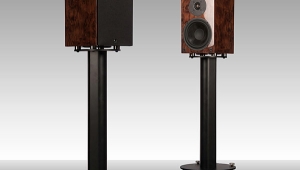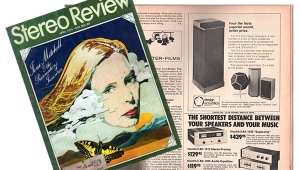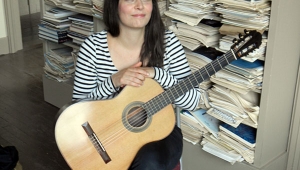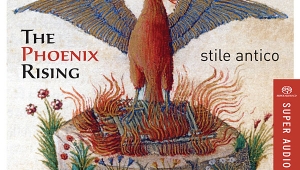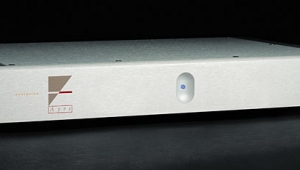| Columns Retired Columns & Blogs |
The Fifth Element #18 Page 3
The Esoteric P-70/D-70 system is an all-out assault. Each piece weighs 55 lbs. Industrial design and fit'n'finish are first-class. The size and shape are nearly identical to the Accuphase units, with the convenient and oh-so-welcome difference that the TEAC transport uses a conventional sliding drawer for the disc, not a trapdoor with a puck thingy. Hosanna!
Footnote 6: In addition to providing 176kHz upconversion, the P-70 allows for 44.1kHz data to go out on a single S/PDIF or optical cable, or 88.2kHz to go out on either. All digital outputs are governed by rear-panel toggle switches, so unused outputs can be muted. The D-70 for its part has three RCA, two TosLink, and two XLR inputs, as well as a "Reserved" input for future IEEE1394 (FireWire) retrofitting.

Disc-access times are very fast, so there's no time to go down to the wine cellar and decant something before the music starts. The transport uses a precision, mirror-polished platter with a very slight convexity, to brace the disc from above. This is claimed to reduce the need for focus-servo correction on slightly warped discs. The transport itself provides user-switchable upconversion, so the 176kHz data go to the DAC on three cables: two XLR balanced digital cables for left and right, and a separate 75 ohm BNC link for word clock (footnote 6). There is even a provision for a separate signal-ground connection (on hardware-store wire, in my case) between the units. Both units have heavy-duty captive-cone, three-point support feet. I placed the P-70 transport on a Symposium Acoustics Ultra isolation platform.
The D-70 DAC is a marvel. Given its 55-lb bulk and the lack of space behind it once I got it onto the shelf, I inadvertently confused the two balanced digital cables that make up the high-resolution AES3 connection. The front-panel pilot lights for both XLR connections came on, but no sound came out of the speakers. Meanwhile, the D-70's front-panel LED screen helpfully pointed out "lf-rt error." Thanks. I'm glad someone knows what they're doing.
The D-70 is the only upconverting DAC I am aware of that enables both regular and upconverted HDCD playback. The D-70 provides three selectable digital filters, one a proprietary design claimed to interpolate data representing frequencies greater than Fs/2, as well as selectable word-clock options and RAM-buffer refresh. To top it all off, there is digitally controlled, optically coupled, variable analog output, so the D-70 can drive a power amp without the need for a preamp (although a separate preamp may provide more gain).
The sound? Just plain absolutely wonderful. Not a trace of glare or grain. Even more important, this was demonstrably not achieved by rolling off the treble to make it sound "more like analog." There was a full measure of detail, which, instead of driving me back into my seat, brought me deeper into the soundstage and deeper into the music (footnote 7).
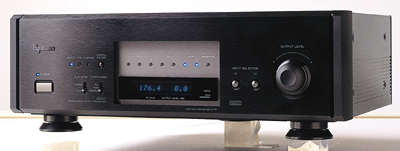
It is one thing to say that one hears things on a treasured recording one has never heard before (such as Jennifer Warnes' Famous Blue Raincoat, which has never sounded better), because there is always the possibility that what one is hearing is just the application of a different—but not necessarily more accurate—equalization curve. It is quite another thing to say that the sense of immediacy, of being enveloped in the world of a treasured recording, is heightened, so that the music as a whole makes sense to one as never before—and that is what the TEAC Esoteric P-70/D-70 did for me. Class A+, in my book. Bravi, bravi, bravi to all who worked on it. Do try to hear it.
Next time: The Dartzeel NHB-108 Model 1, the sweetest-sounding solid-state amp I have ever heard—and, without a doubt, the cake-taker (footnote 8) for soup-to-nuts idiosyncratic uniqueness. I will also report on the Peak Consult InCognitos, which could be the apotheosis of the two-way loudspeaker.
Interrogatories or refutations.
Footnote 6: In addition to providing 176kHz upconversion, the P-70 allows for 44.1kHz data to go out on a single S/PDIF or optical cable, or 88.2kHz to go out on either. All digital outputs are governed by rear-panel toggle switches, so unused outputs can be muted. The D-70 for its part has three RCA, two TosLink, and two XLR inputs, as well as a "Reserved" input for future IEEE1394 (FireWire) retrofitting.
Footnote 7: In evaluating the TEAC combo as well as the Benchmark DAC, I used the Unison Research S2K, Plinius 8200, Halcro dm58, and Dartzeel NHB-108 amplifiers, and Dynaudio Twenty-Five, Duntech 2001, Shahinian Compass, and Peak Consult InCognito speakers, with power cords from Custom Power Cord Company and cable goods from DH Labs, Custom House, Wireworld, and Stereovox.
Footnote 8: This American figure of speech has an interesting origin. The cakewalk was a group social event from the 19th-century South wherein African-Americans would dress in fancy clothes and promenade in couples. There was a competitive aspect to it—imagine linear, competitive ballroom dancing. This custom may extend back into the era of slavery, and may even have African origins. The traditional prize was a cake, awarded to the couple whose "walk" was the most impressive, from whence comes the usage that something "takes the cake." (Music journalists know this because Debussy wrote a "Golliwog's Cakewalk" as part of his Children's Corner Suite.) H.L. Mencken is credited with popularizing the usage "piece of cake" in the 1930s, and that expression, along with "cakewalk" and "takes the cake," became RAF fighter-pilot argot during World War II.
- Log in or register to post comments

